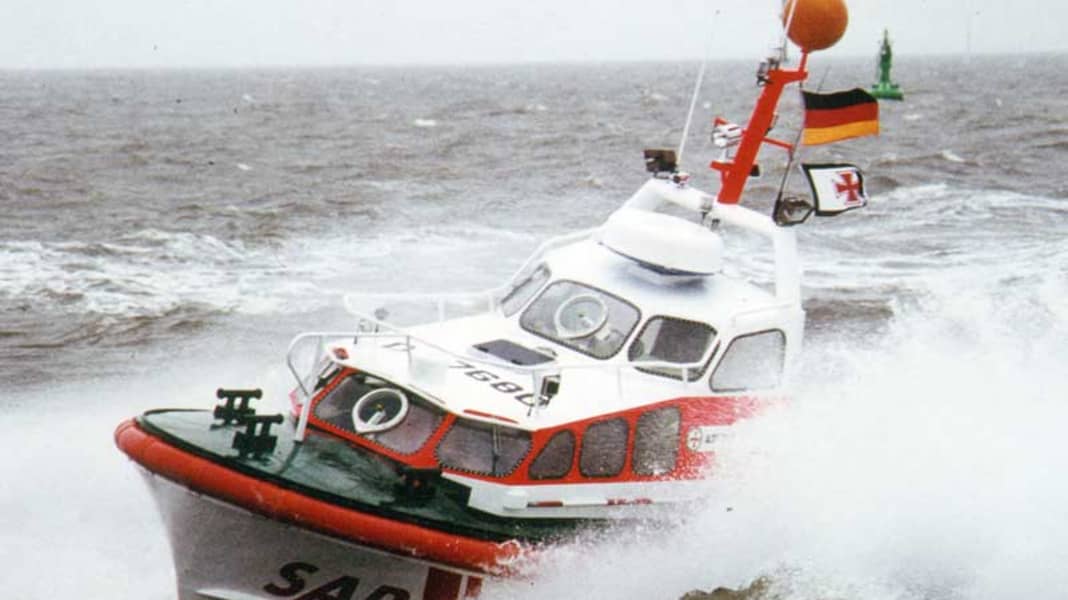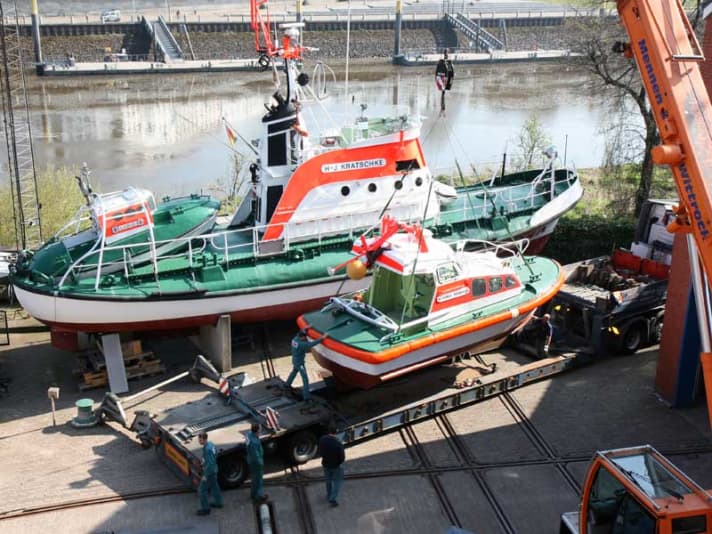
After 25 years of hard sea rescue service, the German Maritime Search and Rescue Service (DGzRS) has decommissioned the type ship of its 8.5 metre class, which was completely newly developed at the time. The "Asmus Bremer", which was commissioned in 1987, will be on display as a technical monument in the German Museum in Munich.

In addition to the "Theodor Heuss", a rescue cruiser from the first series of modern rescue units of the DGzRS, which was also transferred there 25 years ago, the museum will then show the prototype of a modern, all-weather sea rescue boat (SRB) in its exhibition. The "Asmus Bremer" also symbolises the selfless dedication of its sea rescuers, all of whom are volunteers.
Between the end of 1987 and the beginning of 2012, the crews of the SRB rescued 644 people from distress at sea or saved them from imminent danger. In 25 years of service under the flag with the red Hanseatic cross, the rescue boat has covered around 88,000 nautical miles (around 163,000 kilometres) on over 3,900 deployment, control and safety voyages. That corresponds to more than four circumnavigations of the globe.
On Friday, 20 April 2012, experts from Faltus & Bantje Yachttransporte from Weyhe and Autokrane Mennen & Wittrock loaded the rescue boat in the yard of the DGzRS headquarters in Bremen (picture gallery). The ship will now be transported to the Deutsches Museum on a low-loader - a far less spectacular journey than the last voyage of the "Theodor Heuss": 25 years ago, the 23-metre rescue cruiser sailed across the Rhine, Main and Main-Danube Canal to Nuremberg on its own keel. This was followed by a sensational road transport to Munich. From the autumn, "Asmus Bremer" will now also be presented to visitors to the Deutsches Museum. The lifeboat will probably be placed in front of the main entrance.
"Asmus Bremer" was built in 1987 under construction number 1062 as the first rescue unit in the history of the DGzRS at the Fassmer shipyard in Berne-Motzen on the Lower Weser. In 2012, exactly 25 years later, this shipyard, which has since developed and built many rescue boats and larger rescue cruisers for the rescue organisation, delivered the latest rescue cruiser to the DGzRS: a 36.5-metre newbuild for the Sassnitz station.
Like all DGzRS rescue units, the ASMUS BREMER was built using the proven net frame construction method and designed as a self-righting vessel. The key data of the rescue boat:
- Overall length: 8.28 metres
- Overall width: 3.10 metres
- Draught: 0.85 metres
- Engine power: 220 hp
- Speed: 18 knots (approx. 33 km/h)
- Crew: Volunteers
The lifeboat was christened on 21 December 1987 in Kiel-Schilksee by Marina, an orphan from Kiel, in the name of the mayor of Kiel who was in office from 1702 to 1720. It was stationed in the Olympic harbour in Schilksee for its entire service life.
"Asmus Bremer" is the first of three type vessels of a newly developed 8.5-metre class of the DGzRS, which was created after two years of preliminary planning and extensive evaluation of the experience gained with the predecessor types. By the mid-1990s, the DGzRS had put a total of 15 sister ships into service alongside two other prototypes, which gradually replaced the 7-metre sea rescue boats built in the early 1970s.
The new class was developed from the daughter boats of the first two 27.5 metre rescue cruisers that were launched in the mid-1980s. In addition to technical improvements, the declared aim of the DGzRS was to increase speed while maintaining at least the same level of seaworthiness. The main features of the boats:
- a complete navigation/communication system (VHF marine radio double, radar, echo sounder etc.),
- a significantly larger area of application compared to previous buildings,
- Improved sea and bad weather properties (all-weather capable),
- greater reception capacity for shipwrecked persons,
- a salvage port on the starboard side for picking up shipwrecked persons at waterline level,
- an improved towing system with a towing hook on a movable track,
- an all-round fender system for travelling alongside even under difficult conditions,
- extensive rescue and supply facilities,
- a powerful bilge pump for draining (pumping empty) damaged ships,
- a modern searchlight system,
- special safety seats for the crews,
- and - in addition to the interior - a complete exterior driver's cab.
Due to their excellent manoeuvrability and seaworthiness, the 8.5-metre sea rescue boats, like the large rescue cruisers, are also suitable for operations on the high seas, far from the coast and its stations. In the meantime, a further improved third generation of small, powerful rescue boats around ten metres in length is already in service.
Like all DGzRS vessels and their entire work, the "Asmus Bremer" was financed exclusively by voluntary donations, without taxpayers' money. At the Schilksee station, the 8.5 metre long "Franz Stapelfeldt" has now replaced the "Asmus Bremer" alongside the second rescue boat stationed there, the "Marie Luise Rendte".
Today, the DGzRS deploys 61 rescue cruisers and rescue boats from 54 stations in the North Sea and Baltic Sea, operated by 180 permanently employed and around 800 volunteer sea rescuers. The Maritime Rescue Co-ordination Centre (MRCC) of the DGzRS coordinates all operations centrally. In spite of all the technology, the rescue organisation still focuses on the readiness of the sea rescuers for their often dangerous missions. In 2011 alone, the units of the rescue fleet were deployed 2106 times. Their crews rescued 1323 people from distress at sea or freed them from dangerous situations.

